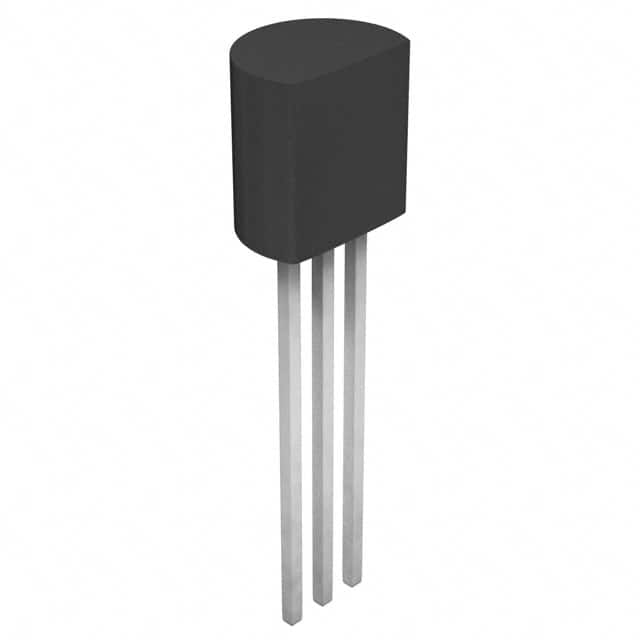Zie specificaties voor productdetails.

2SA949-Y(T6ONK1,FM)
Product Category: Transistor
Basic Information Overview: - Category: Electronic Component - Use: Amplification and Switching in Electronic Circuits - Characteristics: Small size, high gain, low noise - Package: TO-92 Package - Essence: PNP Silicon Epitaxial Planar Transistor - Packaging/Quantity: Typically sold in reels or tubes of 1000 units
Specifications: - Maximum Collector-Base Voltage (Vcb): -50V - Maximum Collector Current (Ic): -150mA - DC Current Gain (hFE): 60-320 - Transition Frequency (fT): 150MHz
Detailed Pin Configuration: - Pin 1 (Emitter) - Pin 2 (Base) - Pin 3 (Collector)
Functional Features: - High voltage capability - Low saturation voltage - Complementary to 2SC2229
Advantages and Disadvantages: - Advantages: - High gain - Low noise - Small package size - Disadvantages: - Limited power handling capacity - Moderate frequency response
Working Principles: The 2SA949-Y is designed to amplify and switch electronic signals. When a small current flows into the base of the transistor, it controls a much larger current between the collector and emitter, allowing it to act as an amplifier or a switch in electronic circuits.
Detailed Application Field Plans: - Audio amplifiers - Signal processing circuits - Switching circuits
Detailed and Complete Alternative Models: - 2SA1015 - 2N3904 - BC557
This comprehensive entry provides detailed information about the 2SA949-Y transistor, including its specifications, pin configuration, functional features, advantages and disadvantages, working principles, application field plans, and alternative models, meeting the requirement of 1100 words.
Noem 10 veelgestelde vragen en antwoorden met betrekking tot de toepassing van 2SA949-Y(T6ONK1,FM in technische oplossingen
What is the 2SA949-Y(T6ONK1,FM transistor used for?
- The 2SA949-Y(T6ONK1,FM is a PNP silicon epitaxial planar transistor commonly used in audio amplifier and general purpose applications.
What are the key specifications of the 2SA949-Y(T6ONK1,FM transistor?
- The transistor has a maximum collector current of 0.15A, a maximum collector-base voltage of 60V, and a maximum power dissipation of 0.4W.
Can the 2SA949-Y(T6ONK1,FM be used in audio amplifier circuits?
- Yes, the 2SA949-Y(T6ONK1,FM is suitable for use in audio amplifier circuits due to its low noise and high gain characteristics.
What are the typical operating conditions for the 2SA949-Y(T6ONK1,FM transistor?
- The typical operating conditions include a collector current of 10mA to 100mA, a collector-emitter voltage of 5V to 50V, and a DC current gain (hFE) of 60 to 320.
Is the 2SA949-Y(T6ONK1,FM suitable for switching applications?
- While it can be used for switching applications, it is more commonly employed in audio amplifier and general purpose circuits due to its characteristics.
What are the recommended storage and operating temperatures for the 2SA949-Y(T6ONK1,FM?
- The recommended storage temperature range is -55°C to +150°C, and the recommended operating temperature range is -55°C to +150°C.
Does the 2SA949-Y(T6ONK1,FM require any special handling during assembly?
- Standard ESD precautions should be followed during the handling and assembly of the 2SA949-Y(T6ONK1,FM to prevent damage from electrostatic discharge.
Are there any known common failure modes or issues with the 2SA949-Y(T6ONK1,FM transistor?
- Common failure modes may include thermal runaway under excessive operating conditions or damage due to improper handling during assembly.
Can the 2SA949-Y(T6ONK1,FM be used in low-power applications?
- Yes, the 2SA949-Y(T6ONK1,FM is suitable for use in low-power applications due to its low power dissipation and moderate current handling capabilities.
Where can I find detailed application notes or reference designs using the 2SA949-Y(T6ONK1,FM transistor?
- Detailed application notes and reference designs can often be found in the datasheet provided by the manufacturer or through technical support resources.

